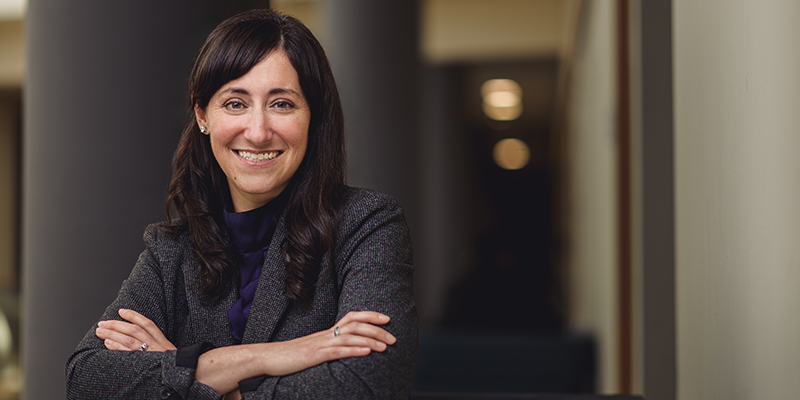Their recent acquisition in the local market included office space at 2211-2219 Arbor Blvd. in Moraine. There are five tenants in the building, mostly focused on medical care. The complete building size is 36,960 square feet.
Caltabiano sees medical office space like the Arbor Boulevard building as an answer to what the world of commercial real estate may look like.
“We like the medical sector because it is one of the strongest performing sectors in the history of commercial real estate,” Caltabiano said.
Working from home not going away
The commercial office market has taken a hit, Caltabiano said, from factors like rising interest rates to the popularity of working from home.
“Ever since the pandemic, working from home is certainly accelerated,” said Riley Dugan, professor and chairperson of the Department of Management and Marketing at the University of Dayton.
Businessess going back to the office full-time is not likely to return to pre-pandemic levels, Dugan said.
“The trend is really reversing, and in fact, I think it’s probably only going to get more pronounced in terms of the number of people who are working remotely,” Dugan said.
A middle ground for businesses can be hybrid working environments where employees have the flexibility to work home certain days of the week while coming to an office other days, he said. In a survey he took part in conducting, he found younger employees still liked the option of working in an office.
ExploreProposed $44M medical center to replace Xenia hospital lacks support from city leaders
“What was interesting is that older workers tended to prefer the hybrid work environment more so than younger workers because younger workers had a stronger desire to go to the office because they felt … it would allow them to increase their networking opportunities,” Dugan said.
Hybrid work environments can still lead to downsizing if companies don’t need to have the space to have all of their employees working from the office at once.
“I do think there still is room for sort of the traditional office experience, but I don’t know if we’re going to need as much office space maybe as we have in the past,” Dugan said.
Commercial landlords are looking at how to utilize the office real estate they already have, and Dugan is seeing owners converting some office space to residential or retail space.
“I definitely think these landlords are going to need to get creative, maybe even more creative, to kind of combat these challenges that they have,” Dugan said.
Health care sector grows
A large part of Dayton’s economy is predicated on medical services, Dugan said.
Health care is one of the largest employers in the region, with more than 14,000 people employed with Kettering Health, the Ohio Department of Development said in 2022, and more than 11,000 people employed at Premier Health.
“I think demand for medical services is only going to increase, which I think leads to inherently an increased demand in office space that’s specifically geared toward serving those companies, those organizations that deal in that trade,” Dugan said.
Health care jobs continue to grow nationwide, according to the U.S. Bureau of Labor Statistics. Health care added 55,000 jobs in July, similar to the average monthly gain of 63,000 over the prior 12 months. This included employment in home health care services, hospitals, and nursing and residential care facilities.
“Health care is still an incredibly important component for everyone, everywhere,” Caltabiano said.
While telehealth is another popular trend patients and doctors are utilizing, not everything can be done virtually.
“You still go to the dentist. You still go to the orthodontist. You still go to the orthopedic surgeon,” Caltabiano said.
Behavioral health shortages continue
While jobs grow, more are still needed, analysts say.
The opioid epidemic and mental health crisis in the U.S. have contributed to an increase in overdoses, suicides and depression in the past two decades, the National Center for Health Workforce Analysis says.
In 2022, approximately 59 million U.S. adults, or 23% of all U.S. adults, had a mental illness and nearly half of them did not receive treatment, the center says.
Nationally, about 49% of Americans live in a mental health workforce shortage area, according to the National Institute for Health Care Management.
This is where Healing Realty Trust found its niche.
“We’re acquiring physical, mental and behavioral health care facilities as a landlord, not as an operator, and we also focus on psychedelic-assisted therapy,” Caltabiano said.
Healing Realty Trust’s niche also includes looking at how real estate can answer needs in the space of mental and behavioral health.
ExploreAlzheimer’s Association helps businesses navigate cognitive impairment at work
“We have a deep understanding of some of the future medicines that are coming down the pike regarding behavioral and mental health care treatment and the real estate infrastructure necessary to create turnkey solutions for those doctors and therapists within that space,” Caltabiano said.
Outside of Healing Realty Trust’s main focus on mental and behavioral health, health care jobs in general are projected to grow 13% from 2021 to 2031, according to the U.S. Bureau of Labor Statistics, which is expected to create approximately 2 million new jobs over the decade.
“We think this industry will perform,” Caltabiano said. “We think it’s been underpriced because of the fact that the entire commercial market has been disrupted.”





